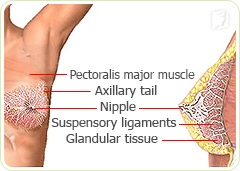
Breast tenderness is a common symptom during menopause and other times of hormonal fluctuation. During menopause, when hormonal levels are in flux, a woman is more likely to develop breast tenderness. Though postmenopausal women may also experience breast tenderness, it is most common in premenopausal and perimenopausal women.
Breast tenderness is a common complaint, affecting as many as 70% of women during their lifetimes. Only a small portion of these women, about 10%, will experience severe breast pain and tenderness, which can have a significant impact on relationships, work, and daily life.
It is important to know that breast tenderness rarely signals breast cancer. Most cases of breast tenderness around menopause are caused by normal hormonal changes in the body. Understanding the causes of breast tenderness during menopause is one of the best ways to manage this symptom. Please read on to learn more about breast tenderness.
Breast Tenderness Definition
Breast tenderness - often referred to medically as mastalgia, mastodynia, and mammalgia - is the general term used to mean discomfort, sensitivity, or pain in one or both of the breasts when touched or when pressure is applied. Some people use the term more generally to mean any breast discomfort.
Many women experience breast tenderness around the time of menstruation or during pregnancy, when the hormones estrogen, testosterone, and progesterone are in flux. As with menstruation and pregnancy, menopause involves hormonal fluctuations, which can trigger breast tenderness and pain.
Breast tenderness can be experienced during different life stages and can vary based on a woman's own unique physiology and genetics. Nevertheless, some symptoms of breast tenderness are universal. Read on to learn more about the common symptoms of breast discomfort during menopause.
Symptoms of Breast Tenderness
Breast tenderness during menopause can be persistent or intermittent. Some women will experience symptoms in both breasts, while for others, breast tenderness will only affect one breast. The following are the most common symptoms of breast tenderness.

- Breast swelling
- Breast soreness
- Increased sensitivity to pressure
- Dull, heavy, or aching feelings
- Discomfort with movement
- Pain while sleeping
- Aches
Please read on to learn more about the different types of breast tenderness that can occur during a woman's life.
Causes of Breast Tenderness
Hormonal change is the most common cause of cyclical breast tenderness during menopause. During the menopause transition, levels of estrogen and progesterone become irregular. Spikes and dips in these hormone levels can lead some women to experience breast tenderness.
Rare Causes of Breast Tenderness
- Breast cancer
- Medication use
- Breast cysts
- Breast trauma
- Prior breast surgery
- Breast size
- Mastitis
- Stress
- Alcohol intake
No one specific hormone has been singled out as the sole contributor to breast discomfort. Progesterone and estrogen can also affect the levels of other hormones, like prolactin.
Additionally, hormone replacement therapy (HRT) used during menopause can also cause breast tenderness. This explains why some women taking HRT continue to experience breast tenderness even after menopause.
Now that the symptoms and causes of breast tenderness are better understood, the next step is to learn more about how to treat breast tenderness during menopause. Because breast tenderness can also be considered a type of breast pain, both are treated with the same approaches during menopause. These approaches range from lifestyle changes and natural therapies to more invasive medical options. To learn more about breast tenderness treatments, please see the information about breast pain treatments.
Sources
- Harvard Health Publications. (2005). Breast pain: Not just a premenopausal complaint. Retrieved April 18, 2016, from http://www.health.harvard.edu/pain/breast-pain-not-just-a-premenopausal-complaint
- National Health Service UK. (2014). Breast pain. Retrieved April 18, 2016, from http://www.nhs.uk/conditions/breastpaincyclical/Pages/Introduction.aspx
